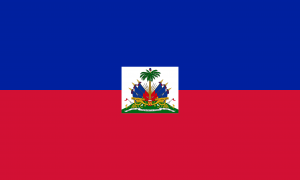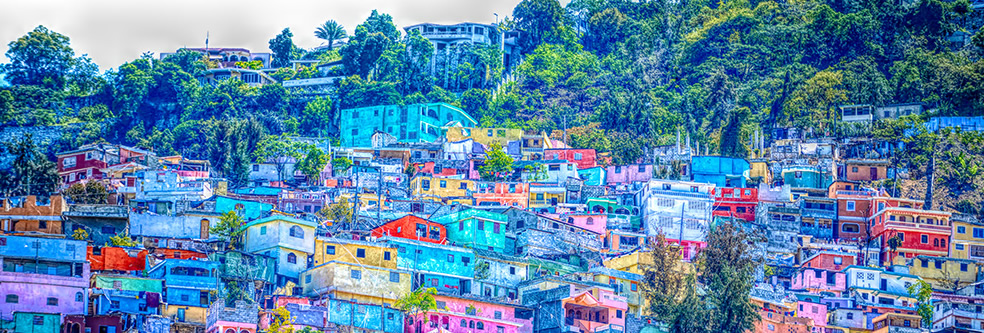Language/Haitian/Culture/Haiti-Timeline
Jump to navigation
Jump to search
Rate this lesson:
Historical Timeline for Haiti - A chronology of key events
Haiti Timeline[edit | edit source]
| 1200 BC AD | Settlement of Arawak tribes in the Greater Antilles. |
| 1492 | Christophe Colomb discovers Haiti. |
| 1503 | Assassination of Anacaona. Arrival of the first black slaves in Santo Domingo (eastern part). |
| 1665 | Installation of Governor Bertrand d'Ogeron who encourages the arrival of the first French recruits (36 months). |
| 1670 | French settlers officially have the right to import African slaves. |
| 1697 | Spain cedes the western part of Hispaniola to France (Treaty of Ryswick). |
| 1758 | The brown slave Makandal, whose stubborn fight heralds future revolts, is burned alive in Cap-Français. |
| 1777 | Blacks and men of color are prohibited from entering France. |
| 1779 | French troops, commanded by Admiral d'Estaing, leave Santo Domingo to lend a hand to the American insurgents. They are made up of over a thousand free men of color and slaves. The future King Christophe is on the trip. They will participate in the Battle of Savannah. |
| 1791 | Bois-Caïman ceremony and slave revolt hardly suppressed by the colonists and free mulattoes. |
| 1793 | Proclamation of the abolition of slavery by Sonthonax, Commissioner of the Republic. The decision was endorsed by the Convention a few months later. |
| 1795 | The Spaniards cede the eastern part of the island to France (Treaty of Basel). |
| 1794-1801 | Ascension of Toussaint Louverture, the new strongman of Saint-Domingue. He was appointed division general by the Directory, then lieutenant-governor of the colony. He proclaims himself Governor General. |
| 1802 | Landing of the troops of Leclerc, Bonaparte's brother-in-law. Announcement of the reestablishment of slavery. Arrest and deportation of Toussaint Louverture. |
| 1803-1804 | Victorious campaign of the troops led by Dessalines on the French army and proclamation of Haiti's Independence in Gonaïves (January 1, 1804). |
| 1805 | Assassination of Dessalines, who in the meantime became emperor under the name of Jacques Ier. |
| 1807-1820 | Scission of the country: in the north, royalty of Henry I, or King Christophe (1811-1816), in the south, presidency of Pétion (1807-1818), mulatto and first Haitian head of state born free. |
| 1815-1816 | Stay of Bolivar in Haiti. He prepared his victorious expedition there, supported by Pétion. |
| 1820 | The country reunites under the presidency of Boyer (1818-1843). |
| 1822 | The Spanish part is attached to Haiti. It will remain under his domination until 1843. |
| 1825 | Recognition by France and its King Charles X of the independence of Haiti in return for the payment of a large indemnity. |
| 1847-1859 | Soulouque president, then emperor under the name of Faustin Ier. |
| 1860 | Signature of a concordat between the Vatican and the Haitian State. |
| 1915 | Assassination of President Vilbrun and start of the American occupation. |
| 1919 | Death of Charlemagne Péralte, hero of the Caco resistance. |
| 1934 | Visit of President Roosevelt. Departure of the Americans (August). |
| 1950 | Election of General Magloire, who succeeds President Dumarsais Estime. |
| 1957 | Election of Doctor François Duvalier. |
| 1964 | François Duvalier is proclaimed president for life. |
| 1971 | François Duvalier designates his son Jean-Claude as successor (January) a few months before dying (August). |
| 1987 | Departure of Baby Doc, released by the Americans (February 7). |
| 1991 | President Aristide comes to power (February) then is forced into exile (September). |
| 1991-1994 | Embargo. General Cédras is the strong man of the regime. |
| 1994 | Return of President Aristide, supported by the international community. |
| 1996 | President Préval succeeds him. |
| 2000 | The results of the legislative elections are contested by the opposition. Beginning of the crisis. |
| 2001 | President Aristide returns to power. The crisis continues. |
| February 29, 2004 | President Aristide resigns and leaves the country. Boniface Alexandre, president of the Court of Cassation becomes interim president, as provided for in the constitution. |
| 2005 | Latortue becomes interim Prime Minister and forms a transitional government. |
| April 30, 2005 | Creation of the Minustah, United Nations Stabilization Mission in Haiti. |
| 2006 | René Préval is elected president. |
| 2008 | Food riots. |
| January 12, 2010 | Earthquake with a magnitude of plus 7 on the Richter scale. |
| 2012 | Election of Michel Martelly, President of the Republic. Cholera epidemic. |
| May 12, 2015 | French President François Hollande is visiting Haiti. He claims to recognize France's "independence debt" to Haiti, but his message is misinterpreted: it is moral recognition and not financial. The gesture is considered insufficient by the Haitian population. |
| October 8, 2016 | Hurricane Matthew hits the south of the country, killing more than 1,000. |
| September 21, 2017 | One year after Matthew, it is Hurricane Maria's turn, two weeks after Irma's passage, to cause damage in Haiti, this time killing 3 people. |
| 20November 2016 | Jovenel Moïse is elected President of the Republic. He takes office on February 7, 2017, succeeding Michel Martelly. |
| February 19, 2018 | The NGO OXFAM finds itself at the heart of an international scandal: its former director as well as two of its employees admit having used the services of prostitutes in 2011 in the Haitian premises of the NGO. |
Source[edit | edit source]
World Timelines[edit source]
Videos[edit | edit source]
Jean Casimir: “A Decolonial Reading of the History of the Haitian ...[edit | edit source]
Haitian Art: "Buried but not Dead" - YouTube[edit | edit source]


